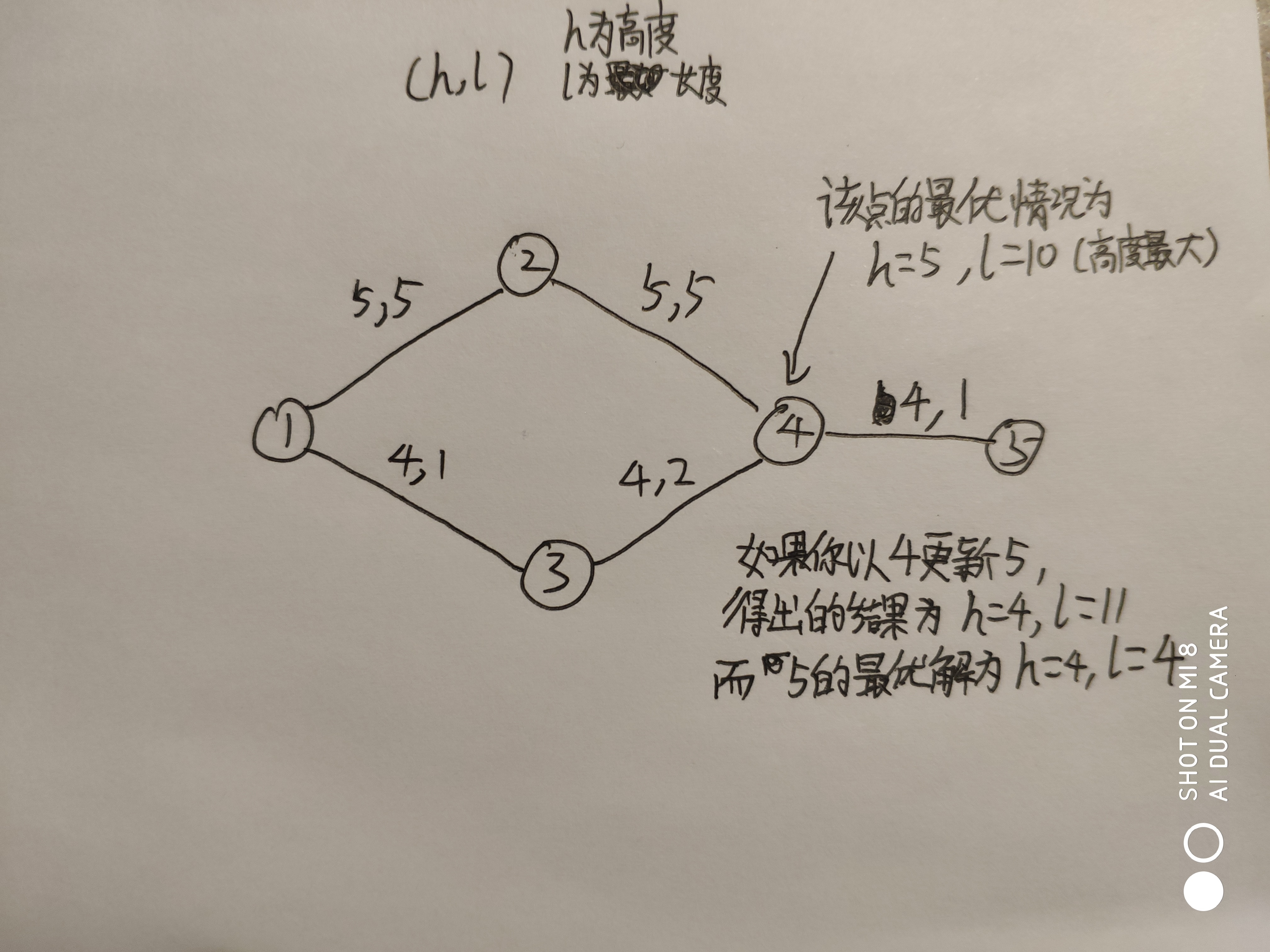UVALive - 4223,hdu2962(简单dijkstra)
Trucking
Time Limit: 20000/10000 MS (Java/Others) Memory Limit: 32768/32768 K (Java/Others)
Total Submission(s): 11419 Accepted Submission(s): 1101
For the given cargo truck, maximizing the height of the goods transported is equivalent to maximizing the amount of goods transported. For safety reasons, there is a certain height limit for the cargo truck which cannot be exceeded.
1 2 7 5
1 3 4 2
2 4 -1 10
2 5 2 4
3 4 10 1
4 5 8 5
1 5 10
5 6
1 2 7 5
1 3 4 2
2 4 -1 10
2 5 2 4
3 4 10 1
4 5 8 5
1 5 4
3 1
1 2 -1 100
1 3 10
0 0
maximum height = 7
length of shortest route = 20
Case 2:
maximum height = 4
length of shortest route = 8
Case 3:
cannot reach destination
题意:有c个城市,r条连接两个不同城市的道路,每条道路都有长度和限制货物的最大高度,货物的高度越高
则能运输的货物越多,所以商人老板想从城市a到城市能运输货物的高度最大可以是多少,当高度最大时,要走的路程总长最短是多少。
输入给出 c 和 r 的大小,接下来有 r 行代表着每条道路的信息,每一行给出相连的城市a,b,道路限制的最大高度(-1代表高度不受限制),道路的长度,道路是双向的。
最后一行给出出发城市,目的城市,货物能到达的初始最大高度。
思路:简单的dijkstra的运用,先用此算法求出能运输的最大高度,再以求出的最大高度为限制求出要走的最短路程。但是要注意不能同时求最大高度和最段路径,
因为当你求出一个点的最大高度和最短路程时,你不能以该点的最段路程来退出它后面点的最短路程,因为加设你当前求出的最大高度为h,最短路径为l,那么如果它连接下一个点的道路的限制小于你当前的最大高度时,你就不能保证下一个点的最短路径是最短的
看下图就知道了

代码
#include<cstdio>
#include<algorithm>
#include<cstring>
#define INF 0x3fffffff
using namespace std;
struct st{
int h,l;
}mp[1010][1010];
st dis[1010];
int vt[1010];
int n,m,nb;
int a2,b2,h2;
int dij(){
int i,j,k;
int mx,mn;
int h;
int c,d,a1;
for(i=1;i<=n;i++){//初始化
dis[i].l=INF;
dis[i].h=-1;
}
dis[a2].l=0;//初始化开始点
dis[a2].h=h2;
k=a2;
while(k!=-1){//求高度
vt[k]=1;
mx=0;//高度
for(i=1;i<=n;i++){
if(!vt[i]&&mp[k][i].l!=-1){
if(dis[i].h<(min(mp[k][i].h,dis[k].h))){//更新每个点的最大高度
dis[i].h=min(mp[k][i].h,dis[k].h); }
}
}
k=-1;
for(i=1;i<=n;i++){
if(!vt[i]){//找出当前高度最大的点 重复操作
if(dis[i].h>mx){
mx=dis[i].h;
k=i;
}
}
} }
h=dis[b2].h;//最大高度
k=a2;
//printf("ww%d\n",h);
memset(vt,0,sizeof(vt));
while(k!=-1){//求最短路径
vt[k]=1;
mn=INF;//长度
for(i=1;i<=n;i++){
if(!vt[i]&&mp[k][i].l!=-1&&mp[k][i].h>=h){//限制条件
dis[i].l=min(dis[i].l,mp[k][i].l+dis[k].l);//更新路径长度
}
}
k=-1;
for(i=1;i<=n;i++){//找出当前路径最小的点
if(!vt[i]){
if(mn>dis[i].l){
mn=dis[i].l;
k=i;
}
}
}
} if(nb>1)
printf("\n");
printf("Case %d:\n",nb);
if(dis[b2].l==INF)//如果不能走到目的城市
printf("cannot reach destination\n");
else
printf("maximum height = %d\nlength of shortest route = %d\n",dis[b2].h,dis[b2].l);
return 0;
}
int main(){
int i,j,l;
int lg=0;
nb=0;
while(scanf("%d%d",&n,&m)&&n){
memset(mp,-1,sizeof(mp));//初始化
memset(vt,0,sizeof(vt));
for(i=0;i<m;i++){
scanf("%d%d%d%d",&a2,&b2,&h2,&l);//输入这条道路相连的两个城市,道路的限制高度,道路的长度
if(h2==-1)
h2=INF;
mp[a2][b2].h=h2;
mp[a2][b2].l=l;
mp[b2][a2]=mp[a2][b2];
}
scanf("%d%d%d",&a2,&b2,&h2);//输入出发城市,目的城市,限制的最大高度
nb++;
dij();
}
return 0;
}
A certain local trucking company would like to transport some goods on a cargo truck from one place to another. It is desirable to transport as much goods as possible each trip. Unfortunately, one cannot always use the roads in the shortest route: some roads may have obstacles (e.g. bridge overpass, tunnels) which limit heights of the goods transported. Therefore, the company would like to transport as much as possible each trip, and then choose the shortest route that can be used to transport that amount. For the given cargo truck, maximizing the height of the goods transported is equivalent to maximizing the amount of goods transported. For safety reasons, there is a certain height limit for the cargo truck which cannot be exceeded. Input The input consists of a number of cases. Each case starts with two integers, separated by a space, on a line. These two integers are the number of cities (C) and the number of roads (R). There are at most 1000 cities, numbered from 1. This is followed by R lines each containing the city numbers of the cities connected by that road, the maximum height allowed on that road, and the length of that road. The maximum height for each road is a positive integer, except that a height of ‘-1’ indicates that there is no height limit on that road. The length of each road is a positive integer at most 1000. Every road can be travelled in both directions, and there is at most one road connecting each distinct pair of cities. Finally, the last line of each case consists of the start and end city numbers, as well as the height limit (a positive integer) of the cargo truck. The input terminates when C = R = 0. Output For each case, print the case number followed by the maximum height of the cargo truck allowed and the length of the shortest route. Use the format as shown in the sample output. If it is not possible to reach the end city from the start city, print ‘cannot reach destination’ after the case number. Print a blank line between the output of the cases. Sample Input 5 6 1 2 7 5 1 3 4 2 2 4 -1 10 2 5 2 4 3 4 10 1 4 5 8 5 1 5 10 5 6 1 2 7 5 1 3 4 2 2 4 -1 10 2 5 2 4 3 4 10 1 4 5 8 5 1 5 4 3 1 1 2 -1 100 1 3 10 0 0 Sample Output Case 1: maximum height = 7 length of shortest route = 20 Case 2: maximum height = 4 length of shortest route = 8 Case 3: cannot reach destination
UVALive - 4223,hdu2962(简单dijkstra)的更多相关文章
- 二分+最短路 UVALive - 4223
题目链接:https://vjudge.net/contest/244167#problem/E 这题做了好久都还是超时,看了博客才发现可以用二分+最短路(dijkstra和spfa都可以),也可以用 ...
- UVALive 4223 Trucking 二分+spfa
Trucking 题目连接: https://icpcarchive.ecs.baylor.edu/index.php?option=com_onlinejudge&Itemid=8& ...
- UVALive - 4223(hdu 2926)
---恢复内容开始--- 题目链接:http://acm.hdu.edu.cn/showproblem.php?pid=2962 Trucking Time Limit: 20000/10000 MS ...
- Fight Against Traffic -简单dijkstra算法使用
题目链接 http://codeforces.com/contest/954/problem/D 题目大意 n m s t 分别为点的个数, 边的个数,以及两个特殊的点 要求s与t间的距离在新增一条边 ...
- UVaLive 4256 Salesmen (简单DP)
题意:给一个无向连通图,和一个序列,修改尽量少的数,使得相邻两个数要么相等,要么相邻. 析:dp[i][j] 表示第 i 个数改成 j 时满足条件.然后就很容易了. 代码如下: #pragma com ...
- UVALive 4223 / HDU 2962 spfa + 二分
Trucking Problem Description A certain local trucking company would like to transport some goods on ...
- UVALive 6486 Skyscrapers 简单动态规划
题意: 有N个格子排成一排,在每个格子里填上1到N的数(每个只能填一次),分别代表每个格子的高度.现在给你两个数left和right,分别表示从左往右看,和从右往左看,能看到的格子数.问有多少种情况. ...
- 图论基础之Dijkstra算法的初探
图论,顾名思义就是有图有论. 图:由点"Vertex"和边"Edge "组成,且图分为有向图和无向图(本文讨论有向图),之前做毕业设计的 ...
- 一些简单二分题,简单的hash,H(i),字符串题
说在前面: 题是乱七八糟的. 几个二分的题. (但是我的做法不一定是二分,有些裸暴力. 1. Equations HDU - 1496 输入a,b,c,d问你这个方程有多少解.a*x1^2+b*x2^ ...
随机推荐
- 3D印表機 零件採購資訊
3D印表機 零件採購資訊 採購資訊僅供參考,零件的品質由店家擔保! 壓克力 螺絲螺帽牙條 高來螺絲 滑套.軸承 五連軸承 掏寶-廣發軸承 光軸 掏寶-廣發軸承 彈簧 雅銅彈簧 鐵氟龍製品 馬達 電源供 ...
- PM九步法
本文转载自网络. 多年以后,当我面对那些年青的产品经理,我会想起自己当年从事的是一份高薪的工作.那是2000年,我大学毕业后在北京一家IT网站做搜索引擎PM,当时我一个月的薪水能在亚运村买一平方米房子 ...
- Poj1258 Agri-Net (最小生成树 Prim算法 模板题)
题目链接:http://poj.org/problem?id=1258 Description Farmer John has been elected mayor of his town! One ...
- SpringMVC登录拦截DEMO
交给/login的post请求的控制器处理, 并通过控制器的逻辑控制获取提示信息login.jsp<%-- Created by IntelliJ IDEA. User: shijinglu D ...
- Yii1自定义 CGridView 中的操作按钮中 CButtonColumn 选项
Yii可以使用CButtonColumn自定义按钮及列样式. 效果展示 <?php $this->widget('zii.widgets.grid.CGridView', array( ' ...
- go 编译:交叉编译&编译执行过程
1. 交叉编译 编译Windows程序和mac程序 GOOS=windows GOARCH-amd64 go build main.go 转自:https://www.cnblogs.com/mafe ...
- DataFrame数据转为list,再逐行写入Excel
首先使用np.array()函数把DataFrame转化为np.ndarray(), 再利用tolist()函数把np.ndarray()转为list, 示例代码如下: # -*- coding:ut ...
- 多台linux主机间免密码登录
即在一台主机上登录另一台主机. 有2台linux主机A.B.A输入命令ssh B的ip地址以连接B,发现需要输入B的登录密码,怎样不需要输入密码呢? 步骤1: 在主机A中,输入ssh-keygen - ...
- CSS【04】:CSS组合选择器
组合选择器 群组(并集)选择器 作用:给所有选择器选中的标签设置属性,可以同时控制多个选择器 格式: 选择器1, 选择器2 { 属性: 值; } 注意点: 必须使用,来连接 选择器可以使用标签名称.i ...
- 使用windeployqt工具来进行Qt的打包发布
https://blog.csdn.net/sinat_36264666/article/details/73305712
